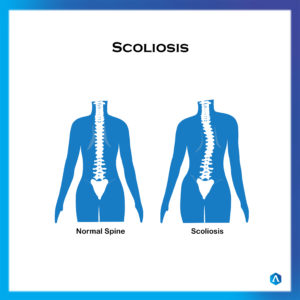Scoliosis
- Dr Abbie Clinics
- August 26, 2019

- Poor posture
- Shorter structural leg-length
- Pelvic twist
- Muscle imbalance
- Hypermobility or ligament laxity
- Activity related such as using only one side of the body in a sport or work activity.
- Biomechanical anomalies e.g. one foot pronates more than the other, causing functional differences.
Symptoms
Common symptoms are:
- Uneven shoulders
- Uneven waist
- One shoulder blade more prominent than the other
- You can see the curvature of the spine
- Bad posture
- Back pain and discomfort
- Foot, hip, knee or leg pain.
Other signs of scoliosis can be one when foot pronates more to compensate for scoliosis; one leg is knock kneed; or one leg bends when the other is straight when standing, to compensate.
Assessment
To confirm scoliosis Dr Abbie Clinics would provide a full biomechanical assessment to identify any structural issues. To confirm any assessment findings and to identify structural or functional differences, a referral for an EOS, X-ray, CT scan or MRI would be provided. This will also will show up the magnitude of the issue, so the correct treatment, if any, can be prescribed. If the patient has come directly to a podiatrist, referral to an orthopedic surgeon via the patient’s general practitioner is recommended, with follow up after surgery to aid rehabilitation. Early diagnosis is important to get the best outcomes.
Treatment
- Depending on severity, straightening the spine via surgery and implanting metal rods, or a wearing brace to improve posture and appearance will be used. The choice of treatment will vary in relation to severity and age. Surgery however is a last resort.
- In most cases the scoliosis is mild and may need no further investigation or treatment. If more significant, regular check-ups may be required before treatment is prescribed.
- Exercise and physical therapy are other methods of easing pain and improving patient health.
- Supportive footwear helps in keeping the foot stable and balanced in everyday activities.
- Orthotics are corrective, medically prescribed innersoles, designed to support, control and align the foot whilst correcting mechanical issues from the feet up.Use of orthotic therapy can help realign the body’s biomechanical structure and provide support. They also help stabilise the heel bone and the growth plate to decrease inflammation and pain. A heel lift may also be necessary to treat or lift a shorter leg.
- If the pelvis is twisted, muscle strengthening exercises may be recommended.
If you or your child are experiencing any of the above symptoms call 1800 DR ABBIE or email reception@dr-abbie.com to organise an assessment.


